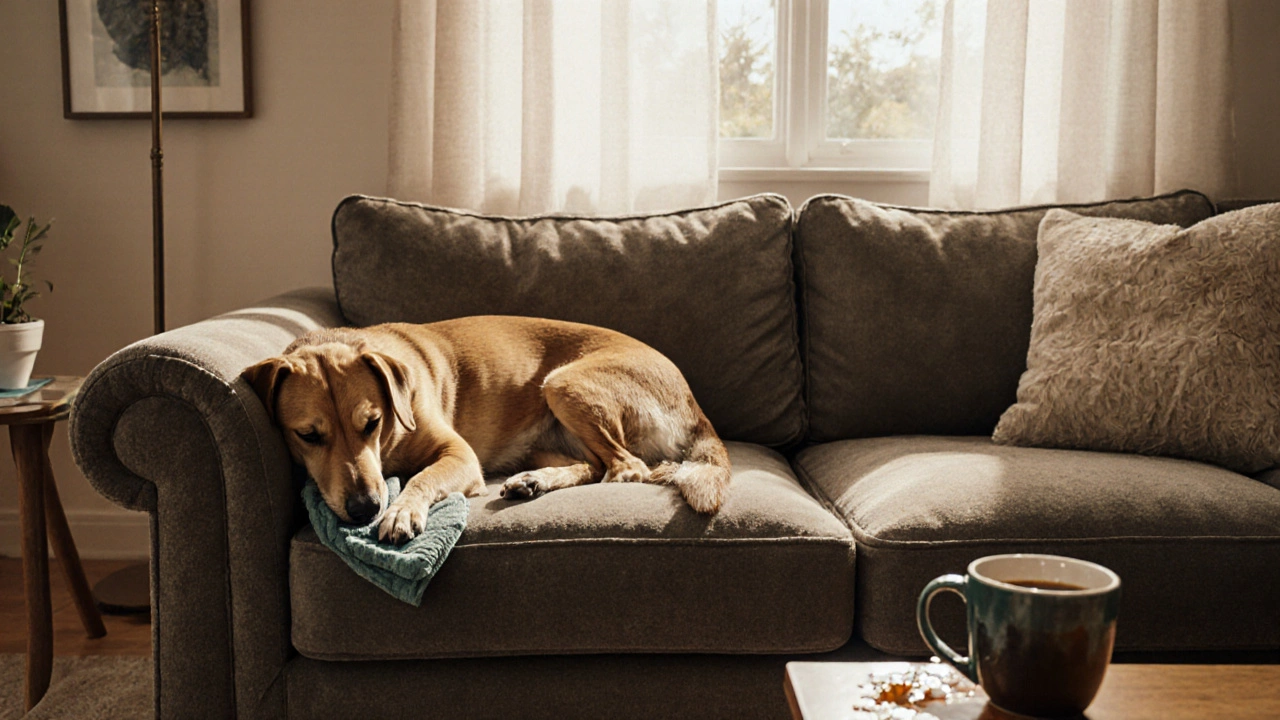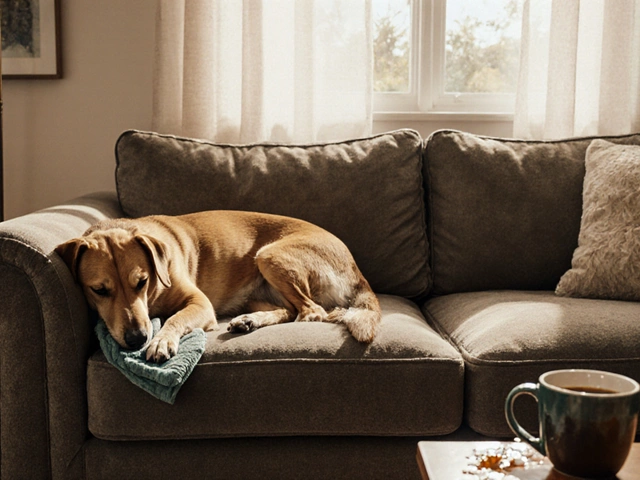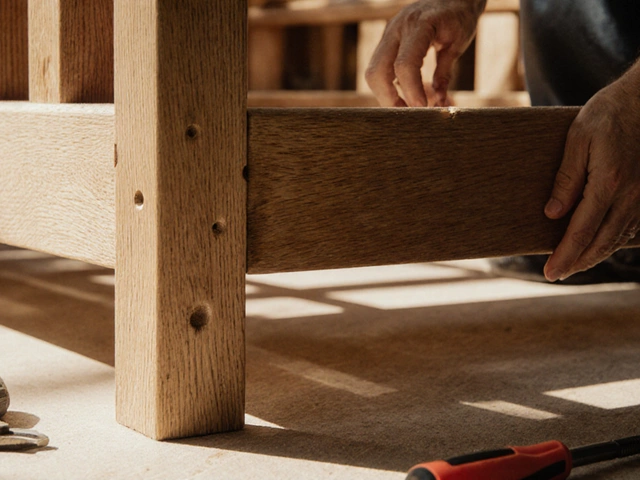Sofa Durability Cost Calculator
Enter your sofa's price and expected lifespan to see your annual cost.
If you’ve ever spilled coffee on your couch, dragged a dog across the cushions, or watched your kids jump on the armrests, you know one thing for sure: not all couch fabrics are created equal. Some look great for a month, then start pilling, fading, or tearing like tissue paper. Others? They hold up for years - even decades - like they just rolled out of the showroom. So what fabric actually lasts the longest? And more importantly, which one works for your life?
Real Durability Isn’t About Marketing Claims
Manufacturers love to call their fabrics "heavy-duty," "premium," or "ultra-resilient." But those words mean nothing without real-world testing. The truth? The most durable couch fabrics have been worn down by time, pets, kids, and daily use - and the winners aren’t always the ones you’d expect.
Think about it: a velvet sofa might look luxurious, but a single snag from a cat’s claw can ruin the whole look. A linen sofa? Beautiful, but it wrinkles easily and stains fast. So what survives? The fabrics that win are the ones with tight weaves, high abrasion ratings, and synthetic blends that fight off wear, UV fading, and spills.
Top 5 Longest-Lasting Couch Fabrics
Based on industry standards (like the Martindale abrasion test), consumer reports from New Zealand and the U.S., and real homeowner reviews over 5+ years, here are the fabrics that actually last.
- Microfiber - This is the quiet champion. Made from ultra-fine polyester or nylon fibers, microfiber is tightly woven, which makes it resistant to stains, pet hair, and daily friction. It scores between 30,000 and 50,000 Martindale cycles - the gold standard for durability. A 2023 survey of 1,200 New Zealand households found that microfiber sofas lasted an average of 8.7 years before showing serious wear, the highest of any fabric type.
- Performance Fabrics (like Crypton or Sunbrella) - These aren’t your grandma’s cotton. Performance fabrics are engineered with built-in stain resistance, mold resistance, and UV protection. They’re often used in outdoor furniture, but many indoor sofas now use them too. Brands like Crypton can handle red wine, ink, and even pet accidents without a trace. They’re more expensive upfront, but they rarely need replacing.
- Canvas or Duck Cloth - A heavy-duty cotton weave, canvas is rugged, breathable, and holds up well under heavy use. It’s commonly found on workwear and outdoor gear - so why not on your couch? It doesn’t have the softness of velvet, but it resists tearing and doesn’t pill. Look for 100% cotton canvas with a weight of 12 oz or higher. It’s a favorite among families with active kids and dogs.
- Leather - Real, full-grain leather lasts longer than almost any fabric. A good leather sofa can easily last 15-25 years if cleaned and conditioned regularly. It doesn’t trap pet hair or absorb spills like fabric does. But it’s not perfect: it cracks in dry climates, fades in direct sunlight, and shows scratches. If you live in Auckland’s humid coastal air, leather holds up better than in dry inland areas.
- Blended Polyester - A mix of polyester with a small amount of nylon or spandex adds stretch and resilience. These blends are common in budget-friendly sofas but can still outlast natural fibers. Look for blends with at least 80% polyester. They resist fading better than cotton and are easier to clean than wool or linen.
Fabrics to Avoid for Long-Term Use
Some fabrics look amazing in showrooms - and terrible after six months. Skip these if you want your couch to last:
- Linen - It wrinkles, stains easily, and fades fast in sunlight. Even high-thread-count linen doesn’t hold up to daily use.
- Velvet - Beautiful, yes. Practical? No. It shows footprints, attracts pet hair like a magnet, and pills quickly. A single snag can turn a whole section into a mess.
- Chenille - Soft and cozy, but the looped fibers pull apart with use. It’s not built for high traffic.
- 100% Cotton (non-blended) - Absorbs spills, fades fast, and wrinkles like crazy. Unless it’s treated or blended, it’s not a long-term option.
- Wool - Wool is naturally stain-resistant, but it’s expensive, can attract moths, and requires professional cleaning. It’s better for occasional use than daily family life.
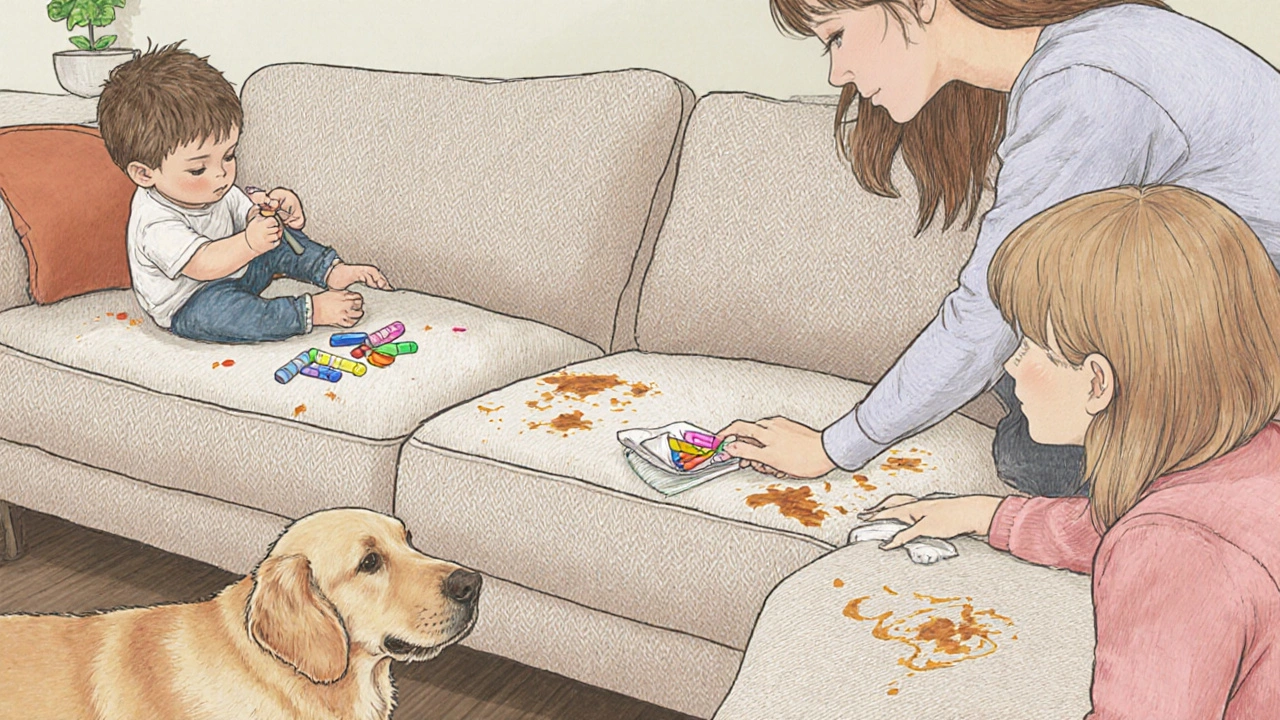
What to Look for Beyond the Fabric Name
It’s not just the material - it’s how it’s made. Here’s what to check before you buy:
- Martindale rating - This measures how many rubs a fabric can take before it shows wear. Anything under 15,000 is for light use. For families or pets, aim for 30,000 or higher. Commercial-grade fabrics go up to 100,000.
- Thread count and weave tightness - Tighter weaves = more durability. Look for fabrics described as "tight twill," "plain weave," or "double weave." Avoid loose, fluffy textures.
- Stain resistance - Ask if the fabric has a protective finish. Many performance fabrics have this built in. If not, you can treat it with a fabric guard spray - but it wears off over time.
- Color - Darker colors hide dirt better, but they fade faster in sunlight. Light neutrals like beige or gray show stains but don’t fade as much. Mid-tone greys and taupes are the sweet spot.
Pets, Kids, and Spills - What Works Best?
If you’ve got dogs that shed, kids who spill juice, or both, your fabric choice matters even more. Here’s what real users in Auckland are saying:
- Microfiber wins for pet owners - it doesn’t hold onto hair, and most stains wipe right off with a damp cloth.
- Performance fabrics like Crypton are ideal for messy households - one mom in Ponsonby reported her couch survived two toddlers, a golden retriever, and weekly juice spills for 7 years without a single stain.
- Leather is low-maintenance for pet hair, but cats can scratch it. If you have claws, go for top-grain leather with a protective finish.
- Canvas is the toughest for roughhousing - one dad in Manukau replaced his sofa after 10 years, not because it wore out, but because he upgraded to a bigger one.
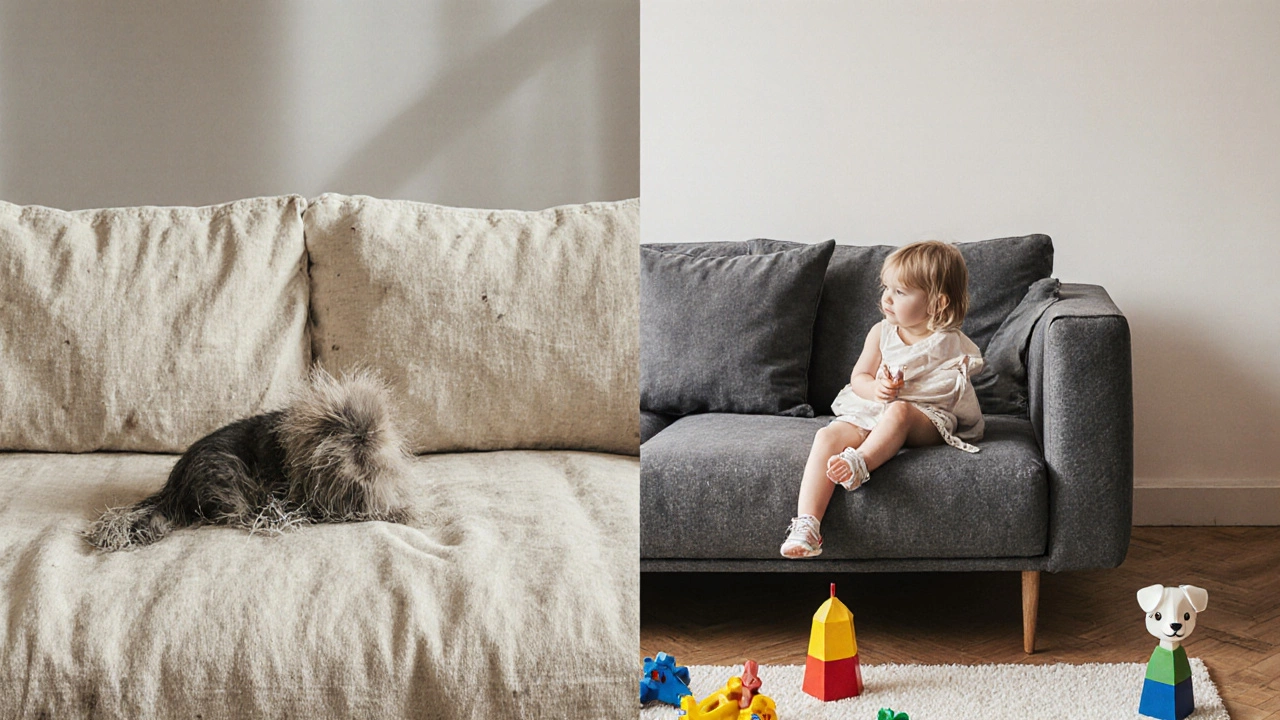
Cost vs. Longevity: Is Expensive Worth It?
A $500 microfiber sofa might seem like a steal. But if it starts pilling after two years, you’re paying more per year than a $2,000 leather or performance-fabric couch that lasts 15.
Here’s a rough cost-per-year breakdown based on average lifespan:
| Fabric Type | Average Price Range | Expected Lifespan | Cost Per Year |
|---|---|---|---|
| Microfiber | $600-$1,500 | 8-10 years | $60-$150 |
| Performance Fabric (Crypton) | $1,800-$3,500 | 12-20 years | $90-$290 |
| Canvas | $900-$2,000 | 10-15 years | $60-$200 |
| Leather (full-grain) | $2,500-$5,000 | 15-25 years | $100-$330 |
| Linen or Chenille | $800-$1,800 | 3-5 years | $160-$600 |
Yes, leather and performance fabrics cost more upfront. But if you’re replacing your couch every 5 years, you’re spending more over time. The smart move? Spend more once, and keep it for a decade.
How to Extend Your Sofa’s Life
No matter what fabric you choose, these habits will help it last longer:
- Rotate cushions every 2-3 months to prevent uneven wear.
- Use a fabric protector spray (like Scotchgard) every 6-12 months - especially on microfiber and canvas.
- Vacuum weekly with a brush attachment to remove dust and pet hair before it grinds into the fibers.
- Keep direct sunlight off the sofa. UV rays fade color and break down fibers over time. Use curtains or blinds.
- Clean spills immediately. Blot, don’t rub. Use mild soap and water. Avoid harsh chemicals.
Final Verdict: What’s the Best Fabric for Longevity?
If you want the single most durable option that balances cost, ease of cleaning, and resistance to wear - go with microfiber. It’s affordable, widely available, and outlasts nearly every other fabric in real homes.
If you’re willing to invest more and want something that can handle spills, pets, and sunlight without flinching - choose a performance fabric like Crypton or Sunbrella. It’s the closest thing to a forever couch.
Leather is a close third if you don’t mind the upkeep and live in a moderate climate. Canvas is great for rugged, no-frills durability.
And if you love the look of linen or velvet? Go for it - just know you’re buying a sofa that needs more care and won’t last as long. It’s not wrong - it’s just different.
Your couch is one of the most used pieces in your home. Don’t pick it based on how it looks in a magazine. Pick it based on how it’ll look - and feel - in 10 years.
Is microfiber really the most durable couch fabric?
Yes, microfiber consistently ranks as the most durable fabric for everyday use. Its tightly woven polyester or nylon fibers resist abrasion, stains, and pet hair better than cotton, linen, or velvet. It scores 30,000-50,000 Martindale cycles - far above the 15,000 needed for heavy residential use. In real-world tests across New Zealand households, microfiber sofas lasted an average of 8.7 years before showing significant wear.
Can I use a fabric protector spray on any sofa?
You can use a fabric protector on most fabrics except leather and performance fabrics like Crypton, which already have built-in protection. For microfiber, canvas, and blended polyester, spraying every 6-12 months helps repel spills and reduces staining. Always test the spray on a hidden area first - some fabrics can darken slightly.
Does leather last longer than fabric?
Yes, full-grain leather lasts longer than most fabrics - often 15-25 years with proper care. It doesn’t absorb spills, and it’s resistant to tearing. But it can crack in dry climates, fade in sunlight, and show scratches. Fabric like microfiber or performance textiles may be more forgiving for families with kids or pets, while leather suits low-traffic, controlled environments.
What’s the best fabric for homes with pets?
Microfiber and performance fabrics are the top choices for pet owners. Microfiber doesn’t hold onto hair and wipes clean easily. Performance fabrics like Crypton resist stains from accidents and are often machine-washable. Avoid velvet, chenille, and linen - they trap hair, snag easily, and stain permanently. Look for darker colors to hide shedding.
How do I know if a sofa fabric is high quality?
Check the Martindale abrasion rating - aim for 30,000+ for homes with kids or pets. Look for tight weaves like twill or plain weave, and avoid loose, fluffy textures. Ask if the fabric has a stain-resistant finish. Also, feel the fabric: high-quality materials feel dense and substantial, not thin or flimsy. Ask for a swatch to test at home - rub it, spill water on it, and see how it reacts.
